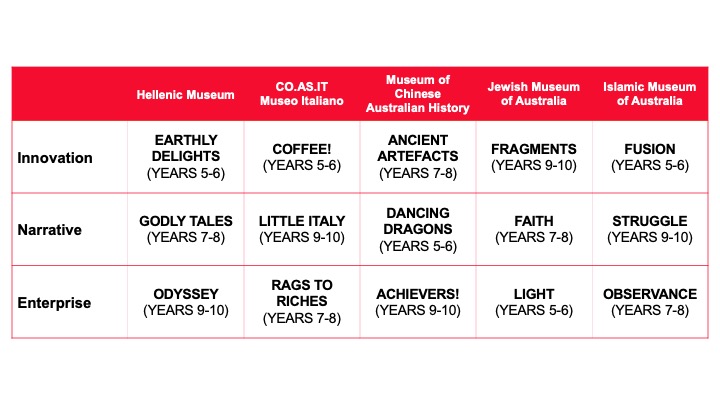TEACHING AND LEARNING UNITS
TEACHING AND LEARNING UNITS
INTRODUCTION
The Multicultural Snapshots Toolkit provides teaching and learning content, activities, and resources to support students gaining knowledge about the history, culture and faiths of the five museum communities represented by Multicultural Museums Victoria.
The Toolkit features selected museum objects to ignite student engagement with multicultural and historical perspectives, intercultural understanding, civic awareness, and the enterprise of migrants and individuals of diverse heritage who form the Australian identity and shape a diverse and innovative Victoria.
There are 15 teaching and learning units in the Toolkit. The teaching and learning units are organised under the themes of Narrative, Innovation, and Enterprise.
Each of the five museums of Multicultural Museums Victoria has produced three units each. Each of these units align with the Victorian Curriculum for Years 5-6, 7-8 and 9-10 respectively.
Each Unit has an associated reference directory, selected web resources, student worksheets and teachers’ tools to support and expand learning.
MULTICULTURAL SNAPSHOTS TOOLKIT UNITS SUMMARY:

CURRICULUM ALIGNMENT: The Humanities and the Intercultural Capability
The Victorian Curriculum F-10, The Humanities recognises the use of historical concepts and skills that have been used to focus the content, activities, and resources for the Multicultural Snapshots Toolkit teaching and learning units:
Historical concepts:
- Historical understanding includes: Evidence, continuity and change, cause and effect, significance, perspectives, empathy, and contestability.
- Civics and citizenship understanding includes: Valuing a diverse and dynamic society, varying points of view, and personal, social, and cultural contributions to local, national, regional, and global civic life as an active and informed citizen.
Historical skills:
- Posing relevant questions, locating sources, critically analysing sources, identifying and applying contextual factors, respecting, and explaining perspectives, substantiating interpretations to develop an informed explanation.
Intercultural capability:
- Intercultural capability aims to develop knowledge, understanding, and skills enabling students to learn to value their own cultures, languages and beliefs, and those of others. The knowledge and skills of Intercultural understanding are taught explicitly in and through the learning areas.
Teaching and Learning Units Structure:
Each of the teaching and learning units within this toolkit are organised according to the Framework for Improving Student Outcomes (FISO) Teaching and Learning Cycle. This cycle encapsulates a 5-part inquiry approach:
- Engagement (Engage) – posing relevant questions about the museum objects – student prior knowledge.
- Building Knowledge (Explore) – locating and analysing historical sources in context, explaining various perspectives.
- Transformation (Explain) – developing informed interpretations and substantiating a response.
- Presentation (Elaborate) – responding to knowledge gained in the previous stages and creating new knowledge.
- Reflection (Evaluate) – evaluating how student historical knowledge and understanding has been advanced through this enquiry.
MULTICULTURAL SNAPSHOTS TOOLKIT TEACHING AND LEARNING UNITS
Museum of Chinese Australian History Units
CO.AS.IT. Museo Italiano Units
Hellenic Museum Units
Islamic Museum of Australia Units
Jewish Museum of Australia Units